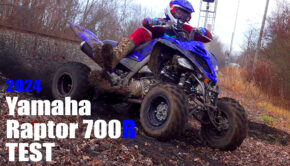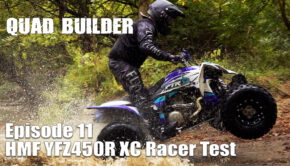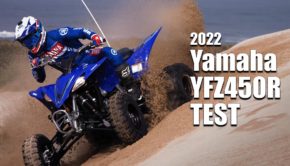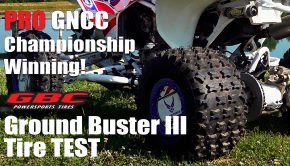Published on June 20th, 2024 | by Joe
2024 Yamaha Raptor 700R GNCC Race Test Review
The 450 sport ATV boom of the 2000s was a blessing and a curse. While it drove the development of sport ATVs and gave us a variety of different race machines to choose from, it, unfortunately, changed something that was historically great about the sport. Until that time, nearly every sport ATV ever produced was at some point utilized as a serious race machine. With the arrival of the 450 class, race mindsets changed, believing that if it isn’t powered by a 450cc engine, it can’t be competitive. We’re sure most of the 250cc two-stroke, dirt bike cross-country racers of the late 80s felt similarly about their 250cc two-strokes, until Scott Summers showed up on his 300-pound Honda XR600 and smoked them all.
With all of the manufacturers turning their backs on ATV Racing except Yamaha, with the YFZ450R, most racers believe that the only machine worth racing currently available on the market is the YFZ. However, we believe that is a mistake. The Raptor 700R was developed partly based on what Yamaha learned from the original race focused YFZ450. Sure, it is a little narrow and has a higher center of gravity, but many overestimate its weight, weighing only 17 pounds more than a YFZ450R. The Raptor’s engine is easily competitively fast, with a high-torque, low-end and midrange focused power delivery that’s more forgiving than a high-RPM focused 450. Its suspension is plush; it features agile, accurate handling; and its brakes deliver 450cc class power and feel. As a benefit, its higher CG yields a slightly higher seat that’s more comfortable, which makes getting off the seat easier the longer the ride.
We’re not claiming that it’s a threat to win a pro-class championship; its displacement alone makes it a non-starter in most pro ATV classes. What we are saying is that in-spite of its shortcomings, the 700R has some distinct advantages that most racers look past. We admit that the Raptor is farthest away from being a competitive motocrosser, although that doesn’t mean you can’t race it in that environment if properly set up. But when it comes to any endurance type racing, cross country, desert, etc., we’ve believed for some time now that the Raptor 700R has its place, and that for some, it might be the ideal weapon for competition. In our recent test of the 2024 Raptor, our test riders, both cross-country racers, felt the 700 has potential for racing.
To find out for sure, we added the minimum modifications to our 2024 Raptor 700R to make it race legal and able to survive a cross-country race. We spent a weekend on testing and setup to dial in the machine. We then headed to the Hoosier GNCC the following weekend to race our nearly stock machine. Our goal was to evaluate how competitive the stock Raptor could be,and gauge its potential for winning races if properly set up.
Race Setup
Our list of mods was short and sweet. To be race legal, we installed a plug and play Pro Armor killswitch from BNR motorsports.
Riding without a steering stabilizer is fatiguing; racing without one is dangerous! With that in mind, we installed one of Precision Racing’s Elite steering stabilizers. Precision Racing stabilizers allow you to fine tune the center and sides of your ATV’s steering separately, minimizing bump feedback through the steering in straightaways, while allowing you to affect bump feedback and traction the turns. It’s a no- brainer upgrade for any high-performance ATV build winning more championships than probably any other single ATV product in history.
A full set of GYTR aluminum skid plates were bolted to the Raptor, covering the A-Arms, chassis, and swingarm, protecting the underside front to back. Ideal for trail riding due to their high level of protection, we knew that a traditional swingarm skid plate would cost us some ground clearance in the ruts, which is why many cross-country racers don’t use them. But, we knew we were less likely to DNF with it due to a damaged chain or rear brake. Constructed of long-lasting aluminum, the swingarm skid plate is especially beefy; a good thing as it will take the most punishment. The skid plate bolts on to the existing mounting points on the swingarm and frame with additional clamps holding the frame and A-Arm skid plates. Rubber bushings on the frame and A-Arm guards eliminate any annoying rattles. Mounting hardware points on the bottom are recessed, protecting bolt heads from easily being sheared off, a nice touch many aftermarket skid plates lack. Fitment was OEM quality as we’d expect from a Genuine Yamaha accessory.
To protect the appearance of our machine, we installed a frame and lower rear fender protection Grip It kit from Dirt Fiend Racing. Similar to skateboard deck tape, these stickers feature a tough, rough textured finish that helps you grip the quad with your knees, especially in the wet, while protecting the frame and rear fenders from scratches. We would hate to ride a new machine without them to protect our investment.
We, at least, wanted to provide our stock Raptor with the benefit of championship winning traction and durability, so GBC Ground Buster III tires were chosen for the job, 21×7-10 front and 20×11-9 rear. Our testing was done with Ground Buster III Pro tires out back, swapping over to standard GB3s for race day to help the tractable four-stroke engine and narrower stance more easily break loose for slides if desired. No other performance parts were added after that, including retaining the stock exhaust and handlebars. This race machine was almost as stock as they come.
Pre Race Testing
With former local cross-country racer ,Evan Hartzel, set to pilot our Raptor on race day, we met up with him at his private test track in Northern Ky. to dial in the machine. Evan’s first impression of the Raptor was that its stock engine felt faster than his piped, Vortex ECU equipped YFZ450R, so even corked up, engine performance shouldn’t be a problem.
Worried about the ride height, we ran 40% rear suspension sag, 10% more than we’d typically run without zero preload shocks where ride height has little effect on how firm or soft the ride is. We set the front ride-height up ½” higher than the rear, then started digging into the clickers. With the rear end kicking a bit in rollers, we slowed the rear shock’s rebound three clicks, which helped settle things down. We then turned to the front shocks, backing out on high and low-speed compression most of the way, adding in enough low speed compression to help resist body roll a bit in turns without feeling harsh over bumps. We then played around with high-speed compression till we found the best compromise between compliance over roots and rocks while still retaining enough bottoming resistance on g-outs and small jump landings. Front rebound damping was left stock.
For tire pressure, we settled on 6 ½ lbs rear and 7 ½ lbs front. A slightly higher air pressure would help provide some flat protection without us having the benefit of a run flat system. The GBSes still provided good accelerating, braking, and directional control, so we were primarily sacrificing a little bit of ride quality over smaller bumps.
For the stabilizer settings, Evan felt that the Raptor’s front end was a little twitchier than his YFZ so he ran a little more damping in the center and sides of the steering than Precision Racing’s recommended base settings.
At 45.5” wide in stock condition, compared to the 47.5” width most cross-country racers set their machines up with, Evan noted that the Raptor gives up a little bit of stability in turns, which might play a role in how he’d ride during the race. But, after a few hours of dialing in the machine, we felt we had made notable improvement in its suspension and handling compared to stock, so with that, it was time to head home and get ready for race day.
Race Test
We arrived at the Hoosier GNCC on Friday to sign up and go through Tech inspection. It rained before we arrived, while we were there, the night prior to the race, then again race morning, so it was going to be a real mudder. We wanted a high level of competition, but didn’t want to interfere with anyone’s championship points, so we signed up for the Sportsman B class, a non-points paying class in the morning, frequented by fast local guys.
We made a couple last minute changes just prior to heading to the race. First, we gave the machine a fresh oil change using Maxims Pro-Plus 10w-40 synthetic motor oil for a little added protection under extreme race conditions. The machine was then given a generous coating of Maxima SC1 to help prevent mud buildup, because, after all, someone has to wash it. As we mentioned, we swapped the rear tires to standard GBC, GB3s for easier sliding in high-traction conditions, which weren’t going to be a factor. They were mounted on a set of DWT rear beadlock wheels just in case we cut a rear tire. Up front, we maintained the stock non-beadlock wheels for the 4+1” offset beadlock wheels we had would have narrowed the front end even more.
The entire course was water-logged, and the starting field was like cake batter. Without the benefit of a 24 volt quick starting setup, Evan had to start the Raptor in neutral with the clutch pulled in, shift to second and takeoff, with others in his class starting in gear, saving time. Off the line, Evan got a decent start. The big four-stroke was so adept at finding traction, especially with the GB3s out back, he actually wheeled a bit in the slop when he shifted up to third gear. With an amazing 3rd place holeshot, we were temporarily dropped to 4th, with Evan regaining 3rd place before he entered the woods.
Evan reported that the suspension was working quite well on the first lap. He closed and passed for second, then reeled in the leader and passed him, putting the big 700 our front. Soon after, the rear skid plate got the machine hung up in some deep ruts, a reason most GNCC racers don’t use them. Two minutes later, Evan was back out there and running down the leader again. He spent much of the race running in 2nd place.
Evan was blowing past 450s in the fields, although he was forced to square off corners, taking advantage of the race worthy braking performance and the engine’s monster torque output to help him quickly get the machine up to speed between turns.
Slipping the clutch was never needed with the 700m making tricky, technical situations in the woods easier to ride with less fatigue. Evan also praised the Raptor’s comfortable seating position for making the ATV less fatiguing to ride in the saddle and easier to get off of.
After becoming stuck for several minutes two more times in the ruts and later in a large bottleneck, he was falling back in the pack due to a lack of proper setup. Our suspension tuning, which worked well in the first lap, proved to be far too soft with an added 70 pounds of mud building. By lap two, the shocks were bottoming occasionally and kicking, forcing Evan to hold back more as the race progressed. We should have added more preload and compression damping to the shocks prior to the race, but we raced to learn and that we did.
In the end, we finished 5th out of the 9 racers in our class. While the finish wasn’t that impressive, we had no expectations of winning. However, we never expected to lead the race for a while either, so there wasn’t much to complain about when it was all said and done, except the 6 hours of cleanup.
Conclusion
After a strong start, managing to run down the leader twice and leading the race for a while, the stock Raptor 700R proved that it is capable of leading a national B class in GNCC racing with very little modification. Had we simply run a racing style sprocket and rotor guard like most GNCC racers, our nearly stock Raptor would have certainly been a threat for the podium if not the win. Some might say that the Raptor can’t be competitive in cross-country racing, but ,in our minds, we’re 100% convinced otherwise. We can make this machine much more capable as a racer, yet still retain all of the advantages that made it competitive for us. If you don’t think the Raptor can be a competitive woods racer, you’d better think again. It’s not just a great trail and dune machine. The Raptor 700R could be a great ATV for racing as well.










